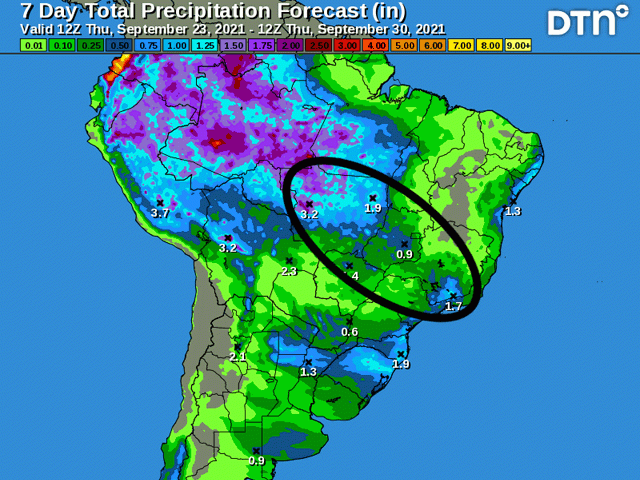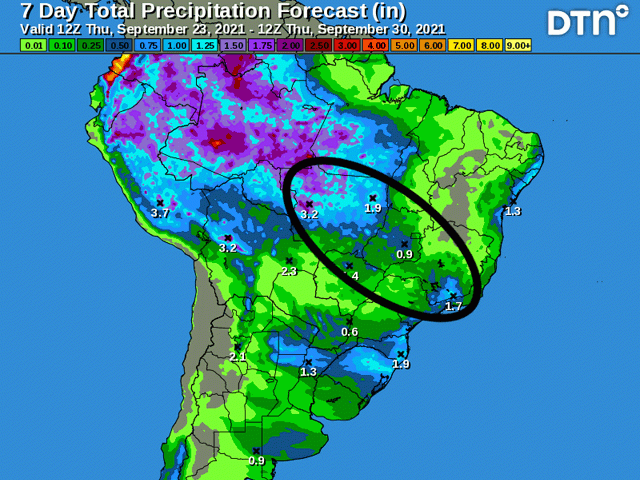South America Calling
Flip-Flopping Forecasts in Central Brazil
Two weeks ago, I mentioned central Brazil could see its wet season start on time. Last week, that looked like a pipe dream and a delay was likely. This week, the forecast changed again.
It is inconsistent forecasts like this that make meteorologists understandably look like fools. I am no stranger to being wrong on weather forecasts, it comes with the gig. And, of course, I do not like to be wrong. But the inconsistency is something I like to avoid. Especially when it comes to bringing insights into something as important as central Brazil's wet season.
Like I have mentioned previously over the last few weeks, central Brazil has a very distinct wet-dry season dynamic being so close to the equator. Wet season rains allow a good share of the region to double-crop soybeans in the spring and summer with corn in the fall and winter, a very lucrative endeavor when all goes to plan. Southern states do not have this typical dynamic, but conditions still allow much of this region to double crop as well.
But the window for this to work out in Brazil is very tight. Wet season rains typically shut down at the end of April or early May, when the double-cropped (safrinha) corn should be in the fill stage. When the weather cooperates, subsoil moisture that builds during the wet season is more than enough to carry the crop through to maturity. But any delays to planting put the corn at risk for entering the dry season during pollination, especially if the dry season comes earlier than normal.
P[L1] D[0x0] M[300x250] OOP[F] ADUNIT[] T[]
That occurred across Brazil last season, when the combination of a late start date and early end date shortened Brazil's wet season by some five to six weeks and forced their safrinha corn to rely almost completely on subsoil moisture through the entire growing season. Production estimates for the last marketing year were down approximately 20% from the prior year, and about 30% down from both public and private forecasts as the safrinha corn was being planted.
That puts into perspective just how important the start to Brazil's wet season truly is. It affects two crops and puts pressure on grain markets the world over.
And now back to the flop in the forecast. A frontal boundary now moving through Argentina will settle into central Brazil this weekend into early next week. The boundary is rather diffuse and weak, which could be the reason models were so wishy-washy about rainfall in the extended range. But it should be enough of a focal point to produce scattered showers for several days in a row across the high production states of Mato Grosso, Goias and Minas Gerais. Whether or not this will mean an official start to the wet season is a little shaky.
In USDA meteorologist Mark Brusberg's presentation about the effects of La Nina on South American agriculture, he defined the wet season as the accumulation of at least 30 millimeters (1.2 inches) of rain. You can find more about the effects of La Nina from Mark here: https://www.usda.gov/….
Using that as a basis, and very little rainfall has fallen for these central Brazil areas since March, the attached image shows that forecasts are calling for some areas to get their start to the wet season, while others are likely to be left behind. This is through the end of September and is the average start for central Brazil's wet season. But models now continue to produce scattered daily showers in the region in early October as well, so any areas that are missed or do not make it to that threshold, should not have to wait long.
Regardless of whether or not the "official" start occurs or not, scattered showers and chances for daily rains thereafter are likely to get producers out into the field and planting at a more rapid pace in the coming weeks. If seeds germinate just fine -- that could be a major if due to the incredibly dry soil -- the soybean crop in Brazil is likely to be on a normal to very slightly delayed pace. That would bode well for both the country's soybean crop as well as their safrinha corn crop, which would likely be planted in the optimum window.
And again, that is important as La Nina tends to shut down the wet season early. If rains continue through the pollination period, the crop will do just fine. And, with expanding acreage, could produce another record crop after a brief break this past season.
For producers in the U.S., an on-time season for Brazil is bad news, as good crops down south will likely lead to better supplies of soybeans come next February or March and corn next June or July. Of course, supply is only one side of the economics, and demand may be the larger driver of grain prices as we continue to leave the pandemic behind us. But it will be something to watch for sure.
John Baranick can be reached at john.baranick@dtn.com
(c) Copyright 2021 DTN, LLC. All rights reserved.






Comments
To comment, please Log In or Join our Community .